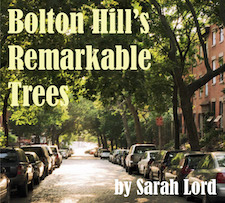
Since July Lagerstroemia’s long-lasting, clustered blossoms have made summer gardens of our streets. White, mauve, raspberry, plum—the Victorian shades of these small trees’ flowers suit Bolton Hill. 
But all good things come to an end: in September their colors fast fade away.
The flowers are “perfect,” meaning they contain both female and male parts. Native to Asia, Lagerstroemia have decorated our southern landscapes since 1790, when French botanist Andre Michaux brought them to Charleston, SC.
The leaves are opposite each other on the twig, and “simple” with “entire” margins: meaning the leaf is not lobed and its edges are smooth rather than serrated. Honeybees and pollinating wasps are attracted to the bright generous flowers and to the residue left from crape myrtle aphid activity. Ladybugs keep the aphids in check.
Next, the leaves will give us nice fall color—but nothing so splendid as the sherbets shades of summer. And finally, all that will be left will be the mottled, smooth bark, which provides interest throughout the winter.
